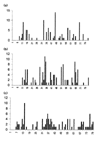IgVH genes from different anatomical regions, with different histopathological patterns, of a rheumatoid arthritis patient suggest cyclic re-entry of mature synovial B-cells in the hypermutation process
- PMID: 11056671
- PMCID: PMC17813
- DOI: 10.1186/ar105
IgVH genes from different anatomical regions, with different histopathological patterns, of a rheumatoid arthritis patient suggest cyclic re-entry of mature synovial B-cells in the hypermutation process
Abstract
In the present study 55 IgVH genes amplified from three different anatomical regions of a rheumatoid arthritis (RA) patient were analyzed, adding further information on synovial B-cell maturation and recirculation in RA. This analysis demonstrated somatically mutated IgVh genes in all regions studied, with amino acid deletions and mixed IgVh molecules, suggesting the existence of a novel pathway to generate (auto) antibody specificities. Comparison of amino acid sequences of amplified genes that belong to the VH1 family (with predominantly the same germline counterpart) exhibited strong homology, indicating an apparently conserved mutational pattern. This suggests that the number of antigens that activate B cells in different locations is restricted. The most striking result was the finding of clonally related sequences in different anatomical regions, indicating a recirculation of activated B cells between the different affected joints.
Figures






Similar articles
-
[Mutational pattern of Ig-VH genes of synovial B-lymphocytes from different anatomical locations in a rheumatoid arthritis patient].Verh Dtsch Ges Pathol. 1999;83:260-9. Verh Dtsch Ges Pathol. 1999. PMID: 10714220 German.
-
IgVH-genes analysis from psoriatic arthritis shows involvement of antigen-activated synovial B-lymphocytes.Z Rheumatol. 2002 Dec;61(6):718-27. doi: 10.1007/s00393-002-0415-5. Z Rheumatol. 2002. PMID: 12491138
-
Molecular analysis of rheumatoid factor (RF)-negative B cell hybridomas from rheumatoid synovial tissue: evidence for an antigen-induced stimulation with selection of high mutated IgVH and low mutated IgVL/lambda genes.Clin Exp Immunol. 1999 Jan;115(1):168-75. doi: 10.1046/j.1365-2249.1999.00767.x. Clin Exp Immunol. 1999. PMID: 9933438 Free PMC article.
-
Morphological and molecular pathology of the B cell response in synovitis of rheumatoid arthritis.Virchows Arch. 2002 Nov;441(5):415-27. doi: 10.1007/s00428-002-0702-1. Epub 2002 Nov 5. Virchows Arch. 2002. PMID: 12447670 Review.
-
Histopathology and molecular pathology of synovial B-lymphocytes in rheumatoid arthritis.Histol Histopathol. 2000 Jul;15(3):791-8. doi: 10.14670/HH-15.791. Histol Histopathol. 2000. PMID: 10963123 Review.
Cited by
-
Autoantibodies as Diagnostic Markers and Mediator of Joint Inflammation in Arthritis.Mediators Inflamm. 2019 Oct 27;2019:6363086. doi: 10.1155/2019/6363086. eCollection 2019. Mediators Inflamm. 2019. PMID: 31772505 Free PMC article. Review.
-
B cells in autoimmune diseases: insights from analyses of immunoglobulin variable (Ig V) gene usage.Autoimmun Rev. 2007 Jun;6(6):387-401. doi: 10.1016/j.autrev.2006.12.005. Epub 2007 Jan 12. Autoimmun Rev. 2007. PMID: 17537385 Free PMC article. Review.
-
Touch-down reverse transcriptase-PCR detection of IgV(H) rearrangement and Sybr-Green-based real-time RT-PCR quantitation of minimal residual disease in patients with chronic lymphocytic leukemia.Mol Diagn. 2005;9(1):23-34. doi: 10.2165/00066982-200509010-00004. Mol Diagn. 2005. PMID: 16035732
References
-
- Dörner T, Brezinschek HP, Brezinschek RI, et al. Analysis of the frequency and pattern of somatic mutations within nonproductively rearranged human variable heavy chain genes. J Immunol. 1997;158:2779–2789. - PubMed
Publication types
MeSH terms
Substances
LinkOut - more resources
Full Text Sources
Medical
Miscellaneous

